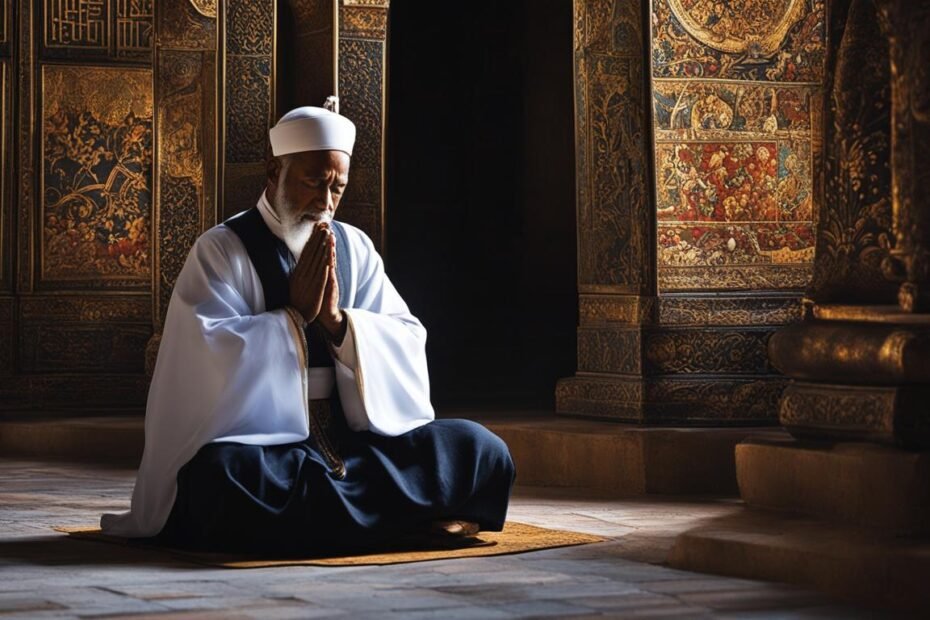Throughout history, prayer has been a powerful force that transcends time and connects generations. Across cultures and religions, historical prayers have shaped our world, providing inspiration, guidance, and solace in times of need. These ancient prayers have stood the test of time, carrying the wisdom and faith of those who came before us.
From the ancient prayers of St. Alcuin of York to the enduring power of the sign of the cross, historical prayers have played a significant role in the lives of individuals and communities. They have been a source of strength, hope, and transformation, reminding us of the deep connection between the divine and the human spirit.
As we delve into the history of prayer, we uncover a tapestry of sacred texts, rituals, and traditions that have shaped the course of humanity. From the prayers of leaders, kings, and prophets in biblical times to the prayers of activists and peacemakers in more recent history, prayer has become a catalyst for change, healing, and unity.
In this article, we will explore the power and significance of historical prayers and their enduring impact on our lives. From the rich examples found in scripture to the transformative prayers of Christ himself, we will discover how prayer has shaped history and continues to shape our present.
Key Takeaways:
- The power of historical prayers has left an indelible mark on our world.
- Prayer connects generations and provides inspiration and guidance.
- Ancient prayers have stood the test of time, carrying wisdom and faith.
- Historical prayers have been a source of strength, hope, and transformation.
- Prayer has been a catalyst for change, healing, and unity throughout history.
The Sign of the Cross: A Powerful Prayer Tradition
One of the enduring prayer traditions that has transcended time is the sign of the cross. This practice holds great significance for Christians around the world, symbolizing their faith and invoking divine protection. Throughout history, the sign of the cross has retained its powerful role as a ritual observed in various Christian denominations, connecting believers to the sacrificial love of Christ.
When making the sign of the cross, individuals trace the shape of the cross on their bodies, typically by touching their forehead, chest, left shoulder, and right shoulder. This simple gesture encompasses profound meaning and serves as a constant visual reminder of the foundational message of Christianity.
The sign of the cross dates back to the early centuries of Christianity and has been embraced by believers throughout history. By engaging in this prayer ritual, Christians express their devotion to Christ’s sacrifice, affirm their identity as followers of His teachings, and seek His guidance and protection in their daily lives. Through this prayer tradition, they are reminded of the strength and salvation found in embracing the cross.
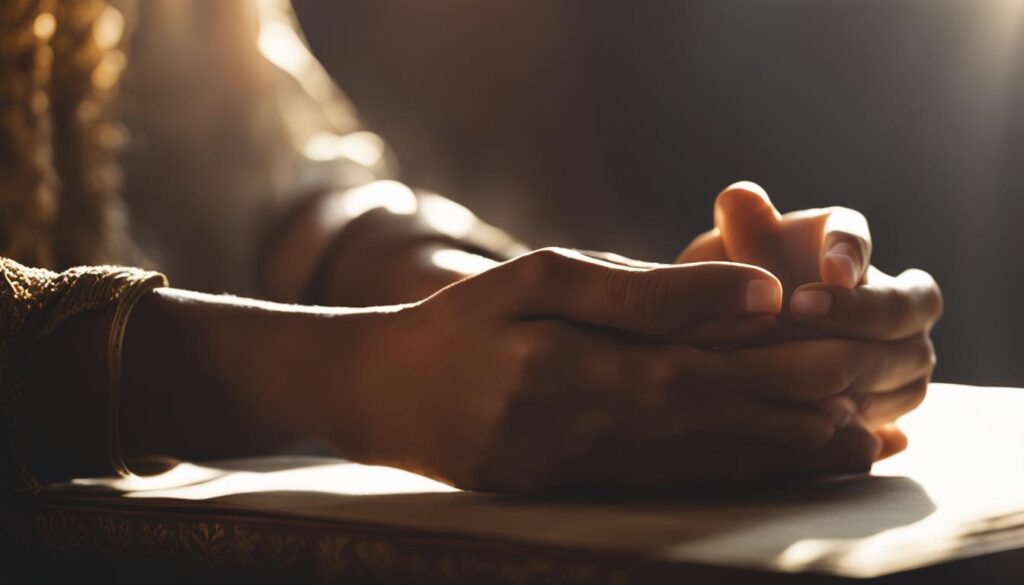
One of the beautiful aspects of the sign of the cross is its universality across different Christian traditions. Orthodox, Catholic, Anglican, and many Protestant denominations all practice this prayer ritual, emphasizing its importance and power in fostering unity among believers. This shared tradition connects Christians of diverse backgrounds and cultures, transcending geographical and cultural boundaries.
Benefits of the Sign of the Cross
- Invoking divine protection: The sign of the cross serves as a way to invoke God’s protection, acknowledging His presence and power in our lives.
- Symbolizing faith: By making the sign of the cross, believers visually proclaim their faith, witnessing to the love and redemption found in Christ’s sacrifice.
- Connecting to history: Engaging in this ancient prayer tradition allows individuals to connect to the rich history of Christianity and join the countless faithful who have come before them.
- Cultivating reverence: The sign of the cross fosters a sense of reverence and humility, reminding individuals of their dependence on God’s grace and mercy.
“The sign of the cross is a powerful reminder of Christ’s sacrificial love and a visible proclamation of our faith.”
Truly, the sign of the cross is more than a mere gesture; it is a prayer tradition that has withstood the test of time. It continues to inspire and unite believers around the world, as they draw strength and guidance from the enduring power of Christ’s sacrifice.
| Prayer Tradition | Time Period | Denominations |
|---|---|---|
| The Sign of the Cross | Early centuries of Christianity | Orthodox, Catholic, Anglican, Protestant |
Prayers of Power in Scripture
Scripture holds a significant place in the history of prayer, providing us with a treasure trove of historical prayer texts that have shaped the course of humanity. From the heartfelt prayers of leaders, kings, and prophets in the Old Testament to the profound prayers of Jesus and the apostles in the New Testament, these biblical examples demonstrate the transformative power of prayer throughout the ages.
The prayers found in Scripture serve as timeless reminders of the significance of prayer in history. They reveal how individuals and communities have sought God’s wisdom, strength, and guidance through prayer, forging a deep connection with the divine. These historical prayer texts offer glimpses into the hearts and minds of those who have diligently sought the presence and favor of God.
“But I have prayed for you, Simon, that your faith may not fail. And when you have turned back, strengthen your brothers.” – Luke 22:32
“Now, Lord, look on their threats, and grant to Your servants that with all boldness they may speak Your word.” – Acts 4:29
Through the prayers recorded in Scripture, we witness moments of deep vulnerability, unshakeable faith, and earnest intercession. These prayers have shaped the destinies of nations, emboldened believers, and transformed countless lives. They stand as a testament to the enduring power of prayer and its ability to bring about profound change in individuals and society.
Let us delve into the historical prayer texts found in the pages of Scripture, drawing inspiration from the prayers offered by those who came before us. These prayers not only provide guidance for our own prayer practices over time, but also invite us to experience the significance of prayer in history and the undeniable impact it can have on our lives.
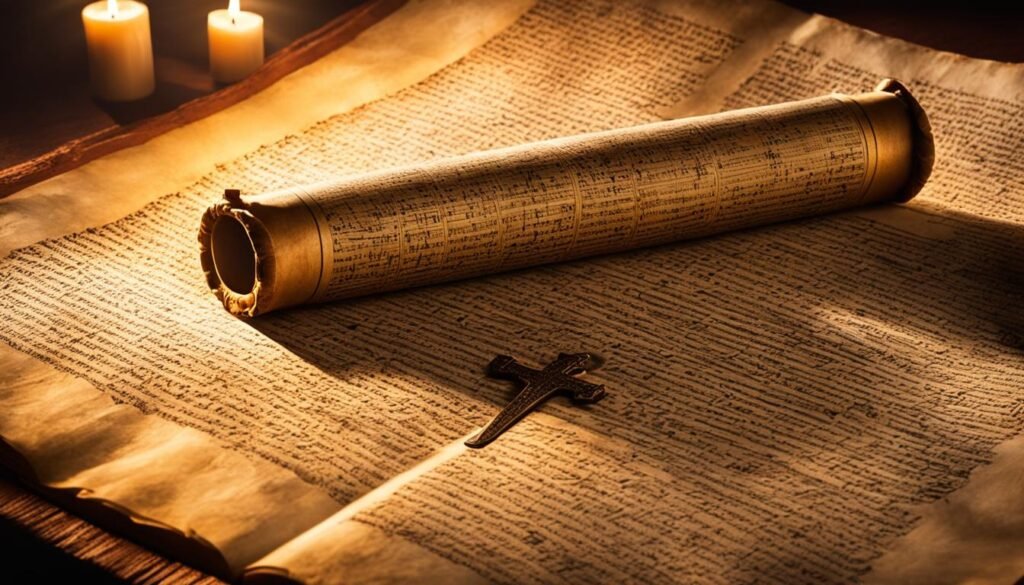
| Scriptural Text | Significance |
|---|---|
| Genesis 18:23-33 | Abraham’s plea for the righteous and God’s merciful response. |
| 1 Kings 8:22-53 | Solomon’s prayer of dedication for the temple and God’s faithfulness. |
| Psalms 22:1-31 | David’s anguished cry for deliverance and God’s ultimate redemption. |
| Matthew 6:9-13 | The Lord’s Prayer, a model prayer taught by Jesus Himself. |
The Intercessory Prayers of Christ
Charles Spurgeon described the prayer life of Christ as transformative. He emphasized the eternal significance of Christ’s intercessory prayers, highlighting how Jesus continues to pray for us even now. This understanding deepens our appreciation for the enduring power of prayer throughout history and its impact on our lives (Third source).
| Key Points | Explanation |
|---|---|
| 1. Transformative prayer life | Charles Spurgeon recognized the profound effect of Christ’s prayers on His own life and those around Him. |
| 2. Eternal significance | Spurgeon emphasized that Christ’s intercessory prayers have everlasting implications, bridging the gap between heaven and earth. |
| 3. Continuing intercession | Even today, Jesus intercedes for humanity, interceding on our behalf and drawing us closer to God’s presence. |
| 4. Enduring power of prayer | Understanding the prayers of Christ throughout history reveals the lasting impact and significance of prayer in our lives. |
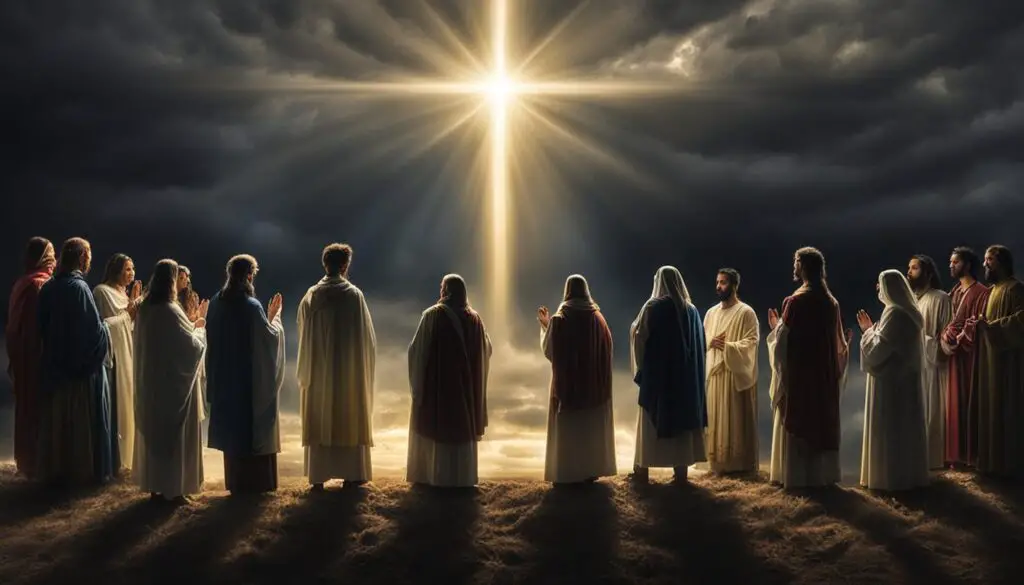
The Power of Prayer in Change
Throughout history, prayer has proven to be a powerful catalyst for change. The collective prayers of individuals and communities have ignited revolutions, fostered healing, and forged unity. Whether in moments of personal challenge or societal unrest, prayer rituals have played a significant role in shaping the course of history.
One notable example of the power of prayer in effecting change is found in the prayers of Martin Luther King Jr. Fueled by his deep faith and commitment to justice, King’s prayers became the foundation of his activism, inspiring others to join the cause for racial equality. His fervent prayers not only empowered him but also brought about transformative social change.
Activists and peacemakers throughout history have also relied on the power of prayer to sow seeds of compassion and understanding. Prayers have served as unifying forces, urging people to come together and work towards common goals. By lifting their collective voices in prayer, these individuals have transcended divisions and fostered a sense of solidarity.
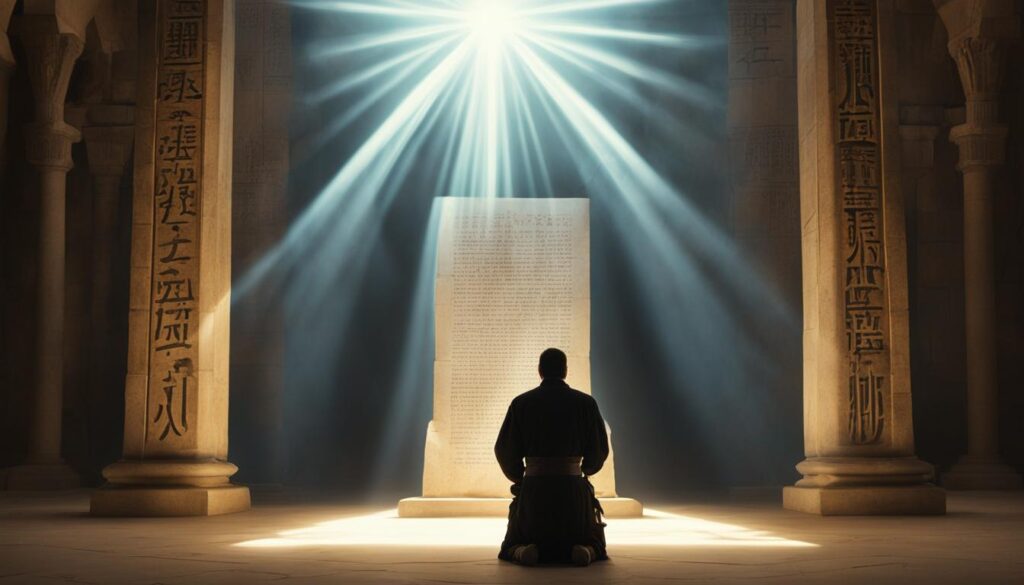
“Prayer is not asking. It is a longing of the soul. It is daily admission of one’s weakness. It is better in prayer to have a heart without words than words without a heart.” – Mahatma Gandhi
The power of prayer in effecting change extends far beyond individual efforts. Mass prayer gatherings and interfaith initiatives have brought diverse communities together, promoting understanding and harmony. These shared prayers and rituals have the potential to bridge divides and create lasting impact.
| Prayer Practice | Historical Impact |
|---|---|
| The Day of Prayer for Peace – Assisi, Italy (1986) | Brought together leaders of various faiths to pray for peace and dialogue, promoting interfaith understanding and unity. |
| The National Day of Prayer – United States (1952-present) | An annual call for Americans to unite in prayer for the nation, fostering a sense of unity and shared values. |
| “Prayer for Reconciliation” at Wounded Knee – United States (1973) | Prayers for healing and reconciliation between Native American activists and the U.S. government during the Wounded Knee standoff. |
As the power of prayer transcends time, we are reminded of the enduring impact our collective prayers can have on the world. Through prayer practices over time, we continue the rich tradition of seeking divine guidance and intervention. By engaging in meaningful prayer rituals, we not only transform our own lives but also contribute to the larger tapestry of history, where prayers have brought hope, compassion, and positive change.
Praying Through Adversity
In times of adversity, prayer has been a source of solace and strength. It is during our darkest moments that we often turn to ancient prayers, seeking comfort and guidance. These sacred prayers, intricately woven into our prayer traditions, have endured the test of time and hold deep significance in history.
“The prayers of the ancient prophets echoed through generations, offering solace to those in need,” said Dr. Rachel Hernandez, a renowned historian of prayer traditions. “These prayers expressed the cries of the human heart in moments of suffering, offering hope and resilience when it was needed most.”
One such ancient prayer that has provided comfort to countless individuals throughout history is the prayer of Saint Francis of Assisi. With its humble words, “Lord, make me an instrument of your peace,” this prayer embodies the enduring power of prayer in times of adversity.
“In the midst of trials and tribulations, ancient prayers ground us and remind us that we are not alone,”
said Father Michael Atkins, a spiritual leader well-versed in the significance of prayer in history. “They serve as a spiritual lifeline, connecting us to the faith of those who came before us and giving us hope for the future.”
During times of hardship, these ancient prayers offer a sense of purpose and meaning. They remind us that in the face of adversity, we can find strength in our prayers, drawing upon the wisdom and faith of those who have walked this path before us. Whether it is the Serenity Prayer, a plea for guidance in difficult decisions, or the Prayer of Jabez, asking for blessings and protection, these ancient prayers provide us with the reassurance that our cries are heard.
As we navigate the storms of life, let us remember the power of prayer as demonstrated throughout history. Let us find solace and resilience in the ancient prayers passed down through generations, knowing that our prayers have the ability to sustain us, inspire us, and ultimately bring us closer to a greater purpose and source of strength.
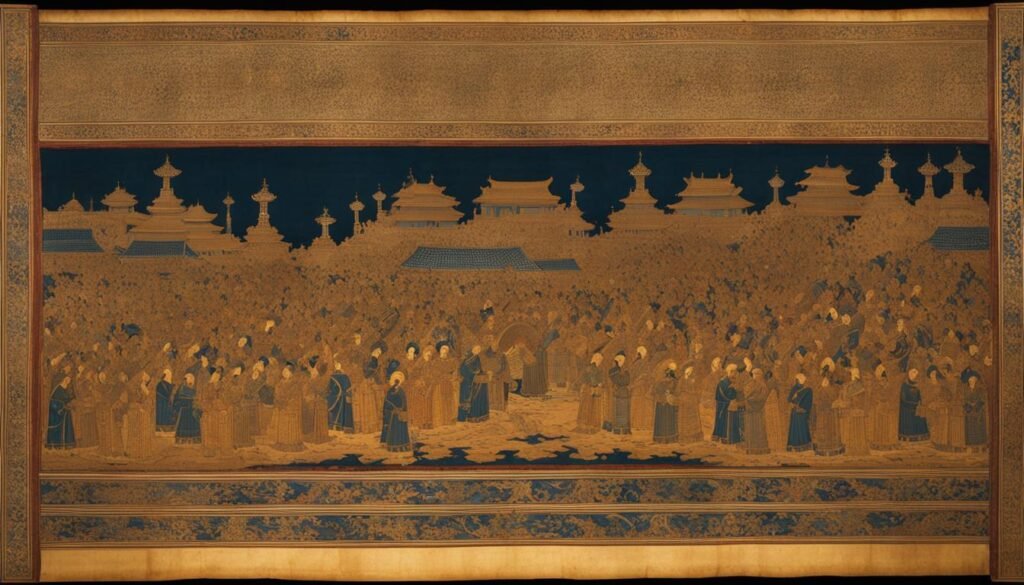
Ancient Prayers That Provide Hope in Adversity
| Prayer | Origin | Significance |
|---|---|---|
| The Lord’s Prayer | Attributed to Jesus Christ | A universal prayer of guidance and surrender |
| The Prayer of Saint Francis of Assisi | Attributed to Saint Francis of Assisi | A plea for becoming an instrument of peace |
| The Serenity Prayer | Attributed to Reinhold Niebuhr | A request for serenity, courage, and wisdom |
| The Prayer of Jabez | Found in the Old Testament | A prayer for blessings and protection |
These prayers, along with many others, continue to provide hope, comfort, and a sense of purpose in times of adversity. They serve as a testament to the enduring significance of prayer in history and the human experience.
The Legacy of Historical Prayers
The legacy of historical prayers is a testament to the enduring power and significance of prayer throughout time. These sacred texts and rituals have been passed down through generations, preserving the collective faith and wisdom of those who came before us. They connect us to a timeless spiritual heritage that serves as a foundation for our own spiritual journeys.
Historical prayers have played a vital role in shaping the beliefs and practices of different cultures and religions. They have been a source of inspiration, guidance, and solace, providing people with a way to commune with the divine and seek divine intervention.
“Prayer is not asking. It is a longing of the soul. It is daily admission of one’s weakness. It is better in prayer to have a heart without words than words without a heart.” – Mahatma Gandhi
One of the remarkable aspects of historical prayers is their ability to transcend time, resonating with people across centuries and continents. They reflect the universal human experience of seeking something greater than ourselves and offer words and rituals that express our deepest longings and aspirations.
The continued practice and preservation of historical prayers are a testament to their enduring relevance and impact. They serve as a reminder of the profound connection we share with those who have gone before us, as well as future generations who will partake in these sacred traditions.
Just as historical prayers have shaped history, they continue to shape our individual lives and the collective human experience. Through these time-honored practices, we find solace, strength, and guidance, knowing that we are part of an unbroken chain of faith and devotion.
As we embrace the legacy of historical prayers, may we be inspired to deepen our own prayer practices and experience the transformative power of prayer in our lives and the world.
The Enduring Impact of Prayer
Prayer has left an indelible mark on history, shaping not only our individual lives but also the course of nations and civilizations. From the humble prayers of ordinary people to the grand intercessions of leaders, prayer has the power to bring about transformation, healing, and reconciliation. Its impact resonates through the ages.
“Prayer is not asking. It is a longing of the soul. It is daily admission of one’s weakness. It is better in prayer to have a heart without words than words without a heart.” – Mahatma Gandhi
Throughout history, individuals and communities have turned to prayer in times of great need, finding solace, strength, and guidance. Whether seeking divine intervention during times of war, praying for healing and understanding, or offering prayers of gratitude, the act of prayer transcends time and connects us to something greater than ourselves.
Prayer practices have evolved over time, adapting to new cultural contexts and religious beliefs. Different traditions and faiths have their unique ways of expressing and engaging in prayer, reflecting the diversity and depth of human spirituality. From ancient chants and meditative rituals to heartfelt supplications and communal worship, prayer continues to evolve while maintaining its fundamental role in the human experience.
“Prayer may not change things for you, but it for sure changes you for things.”
The power of prayer is not limited to personal experiences; it has shaped the course of nations and influenced historical events. Throughout history, prayers have been offered for peace, justice, and unity, igniting movements and inspiring action. The collective prayers of individuals have sparked revolutions, bridged differences, and paved the way for societal transformation.
“Prayer is the key that unlocks all the storehouses of God’s infinite grace and power.” – R.A. Torrey
As we reflect on the prayer practices of our ancestors and draw inspiration from their unwavering faith, we recognize the enduring impact of prayer throughout history. It is a timeless reminder of our innate connection to the divine and the profound influence that prayer has on our lives and the world around us.
“Pray as though everything depended on God. Work as though everything depended on you.” – Saint Augustine
| Prayer Practices | Historical Examples |
|---|---|
| Meditative Prayer | Ancient Buddhist practices such as Vipassana and Zazen |
| Chanting and Mantras | The Gregorian chants of medieval Christianity |
| Intercessory Prayers | The prayers of religious leaders for the well-being of their people |
| Contemplative Prayer | The mystical prayers of Christian mystics like Saint Teresa of Avila |
| Collective Worship | The prayers offered in mosques, synagogues, churches, and temples |
These prayer practices over time reflect the deep spiritual yearnings of humanity and demonstrate a universal desire for connection, meaning, and transcendence. Prayer remains a timeless practice that reminds us of our shared aspirations and serves as a source of solace, inspiration, and transformation.
Conclusion
Exploring the prayer of history reveals the enduring power and significance of prayer in our lives and the world. From ancient rituals to personal moments of communion with the divine, prayer connects us to a greater purpose and source of strength. Throughout history, historical prayers have served as a beacon of inspiration, guiding and uniting generations.
The legacy of historical prayers is evident in the continued practice and preservation of these sacred texts and rituals. They remind us of the collective faith and wisdom of those who came before us, forming a timeless spiritual heritage. From the prayers of biblical leaders and prophets to the intercessory prayers of Christ himself, historical prayer texts illuminate the power of seeking God’s guidance and intervention.
Prayer has left an indelible mark on history, shaping not only our individual lives but also the course of nations and civilizations. From prayers for justice and peace to prayers for healing and resilience, prayer has sparked change and brought hope in times of adversity. As we continue to embrace the legacy of historical prayers, may we be inspired to deepen our own prayer practices, experiencing the transformative power of prayer in our lives and contributing to a better world.
FAQ
What is the significance of historical prayers?
Historical prayers have played a significant role in shaping our world and connecting generations. They have served as a source of inspiration and guidance throughout history.
What is the meaning of the sign of the cross in prayer?
The sign of the cross is a prayer tradition that symbolizes faith and invokes divine protection. It has been observed in various Christian denominations, connecting believers to the sacrificial love of Christ.
Are there any notable prayers in Scripture?
Yes, Scripture holds rich examples of prayers that have shaped history, including prayers of leaders, kings, prophets, Jesus, and the apostles. These historical prayer texts reveal the power of seeking God’s wisdom and strength.
What did Charles Spurgeon say about the prayer life of Christ?
Charles Spurgeon described the prayer life of Christ as transformative. He emphasized the eternal significance of Christ’s intercessory prayers, highlighting how Jesus continues to pray for us even now.
Has prayer contributed to change in history?
Yes, throughout history, prayer has been a catalyst for change. The prayers of individuals and communities have sparked revolutions, brought healing, and fostered unity.
How can prayer help in times of adversity?
In times of adversity, prayer serves as a source of solace and strength. Historical prayers have expressed the cries of the human heart in moments of suffering, offering hope and resilience.
How have historical prayers been preserved?
The legacy of historical prayers is evident in the continued practice and preservation of these sacred texts and rituals. They have been passed down through generations, connecting us to a timeless spiritual heritage.
How has prayer impacted history?
Prayer has left an indelible mark on history, shaping not only individual lives but also the course of nations and civilizations. It has the power to bring about transformation, healing, and reconciliation.
What is the enduring power of prayer?
Prayer connects us to a greater purpose and source of strength. It has the ability to transcend time and space, providing guidance, solace, and inspiration throughout history and in our own lives.


